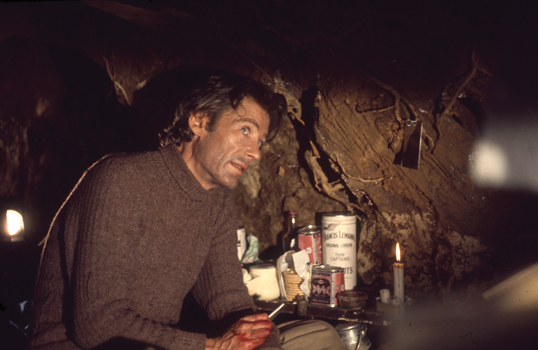Ines Cavill on another Search for Rogue Male
“I chose southern England, with a strong preference for Dorset. It is a remote county, lying as it does between Hampshire, which is becoming an outer suburb, and Devon which is a playground. I knew one part of the county very well indeed……” Rogue Male by Geoffrey Household, 1939
“A track worn down by the traffic of ages and the fretting of water and in places reduced sixteen or eighteen feet beneath the level of the fields.”
Holloway by Robert Macfarlane, 2012
It is 80 years since the publication of Geoffrey Household’s enduring thriller Rogue Male. His cult novel perfectly distilled the suspense wrought from a hunter turned prey, inspiring 8 decades of storytellers including Fritz Lang’s 1941 film Man Hunt, David Morrell’s First Blood, Frederick Forsyth’s Day of the Jackal and the 1976 BBC screen adaptation. Peter O’Toole stars in this as Household’s would-be assassin who fails to shoot Hitler, escapes torture by the Gestapo and flees back to the UK pursued by the sinister Major Quive-Smith (played by John Standing). Peter O’Toole said in 2007 that it remained his favourite of all the films he had worked on, and Rogue Male continues to fascinate—Benedict Cumberbatch has most recently secured the rights to the book he describes as one of ‘the most treasured of English novels’ and will produce and star in a new film that’s in development.
Born in 1900, Geoffrey Household was educated in the West Country and Oxford. In his twenties, he worked throughout Europe from Bucharest to Bilbao (from banking to bananas!) and started an early period of literary work in New York including screenwriting for CBS. But by 1933 he was back and broke in England, spending time walking the countryside of Wiltshire and Dorset until international sales work for an ink manufacturer gave him the scope he wanted to travel and write. His first of 36 books, the novel The Third Hour, was published in 1938 but it is the following year’s Rogue Male that would prove to be an instant best seller—it was even issued as a morale-boosting Services and Forces special edition—and his genre-defining masterpiece.
Rogue Male is unforgettable for its pace and plotting but also the tangible descriptions of place that breathe authentic life into the story. As when the hunted hero seeks sanctuary in ‘the green depths of Dorset’ and arrives just after midnight ‘…on the ridge of a half-moon of low rabbit-cropped hills, the horns of which rest upon the sea, enclosing between them a small, lush valley. The outer northern slopes look down upon the Marshwood Vale….’
From here he drops down into the network of holloways—‘these trade-worn cantons of red and green upon the flanks of the hills are very dear to me’ locating a thick hedge accessed from old lanes leading back to the ridge ‘in the heart of this hedge, which I had been seeking all the way from London, the lane reappears. It is not marked on the map. It has not been used, I imagine, for a hundred years’. Inside this ‘double hedge’, guarded by ‘sentinel thorns at the entrance’ he digs out a den and goes to ground until a shocking final confrontation with his hunter, Major Quive-Smith.
These vivid details and tantalising clues have periodically compelled a search for Household’s original hideout. Christoper Roper wrote about one—‘Geoffrey Household’s Lost Lane’—for this magazine in 2003. He was enthralled by Rogue Male’s stunning descriptions of the Marshwood Vale’s secret places when he moved to North Chideock and could recognise the ‘small lush valley’ on his doorstep and the contours of the hero’s hideaway in nearby holloways like Hell Lane, ‘I shared the book with lots of local friends, all were impressed by Household’s meticulous knowledge of topography and one neighbour said the book was so realistic he could picture the Nazis coming over the hill and through his window!’
The nature writers Robert Macfarlane and Roger Deacon continued this quest in the summer of 2005 approaching the distinctive crescent of hills from the south with bill hooks and sleeping bags ready to take shelter for the night deep inside an ancient track like Rogue Male himself. Macfarlane went on to explore the origin and nature of these holloways in the 2012 prose-poem ‘Holloway’ and defined his topographical muse as “A sunken path, a deep and shady lane. A route that centuries of foot-fall, hoof-hit, wheel-roll and rain-run have harrowed into the land”.
Both these explorations concluded that Household might well have disguised the exact location of the runaway’s lair as cunningly as his ingenious protagonist. But there is rumour of another theory that I set out to hear last month with the storyteller Martin Maudsley. We met with George Streatfeild at Denhay Farm to be taken to see the site his father John had believed to be the novel’s central location. George told us about the beginnings of the farm as we followed him out of the farmhouse towards the dairy. “Daddy bought Denhay after he retired from Navy—though he would forever be known locally as ‘the commander’—and back then in the fifties, it was 250acres of bogs, brambles and bunnies”. This was already sounding a lot more like Household’s literary landscape than 21st Century Dorset.
We were approaching the crucial ridge from the North as Rogue Male does when he is heading towards the sea after sleeping in fields around Powerstock via ‘a remnant of the old Roman road from Dorchester to Exeter’ with his rickety tandem bike ‘the beastly Combination’. The field rose steeply up Denhay Hill leaving the cows below, inky rooks wheeling high above, storm-proof primroses at our feet, the remains of an old farm road and derelict cottage to one side and the high line of the promised crescent ahead with sea sparkling beyond. George describes how a network of tracks crisscrossed farms from the coast to the depths of the vale, ‘We’re still finding the beach pebbles that were picked up and dumped by empty carts on the tracks when they were on a return run from the sea…”.
We turn to look back north over the sweep of the vale’s distinctive small fields edged by hearty hedges with occasional handsome oaks, left as George explained for each ‘chain’ of the hedges that were laid in winter when the cows were inside. Towards the top, the soil changes from heavy clay to Bridport Sand, the kind of ground that lends itself to high-sided holloways, and there running down a small valley on a par with Household’s description is the groove of a once substantial track. Had ‘the commander’ come closest to cracking the code of literature’s most tantalising lair? Its previously unkempt double line of overgrowing hedge trees have been cut right back, but it definitely has potential—and still enough cover to shelter us and George’s German wire-haired pointer Brychan from a heavy shower.
Martin collects folklore and says the uncanny qualities of holloways have always generated their own tales—the deep grooves in their sandstone sides were once attributed to scratches by Dorset’s ‘Colepixies’……
Geoffrey Household died in October 1988 aged 87. His son wanted to scatter his ashes in the holloway that inspired his father’s classic novel, but he too could not be certain of its exact location in that maze of old tracks and chose instead a hill-top view of the Marshwood Vale.
On Wed April 24 Bridport’s Film Festival ‘From Page To Screen’ is showing The BFI’s reissue of the 1976 version of Rogue Male which has been re-mastered from the original 16mm film negatives.
There are just 28 places for this special event. Tickets are £10 from the Bridport Arts Centre Tel. 01308 424 204. Rendezvous 1 pm in car park behind Symondsbury’s Manor Yard to explore the nearby holloways with Martin Maudsley before a ‘secret’ screening.










